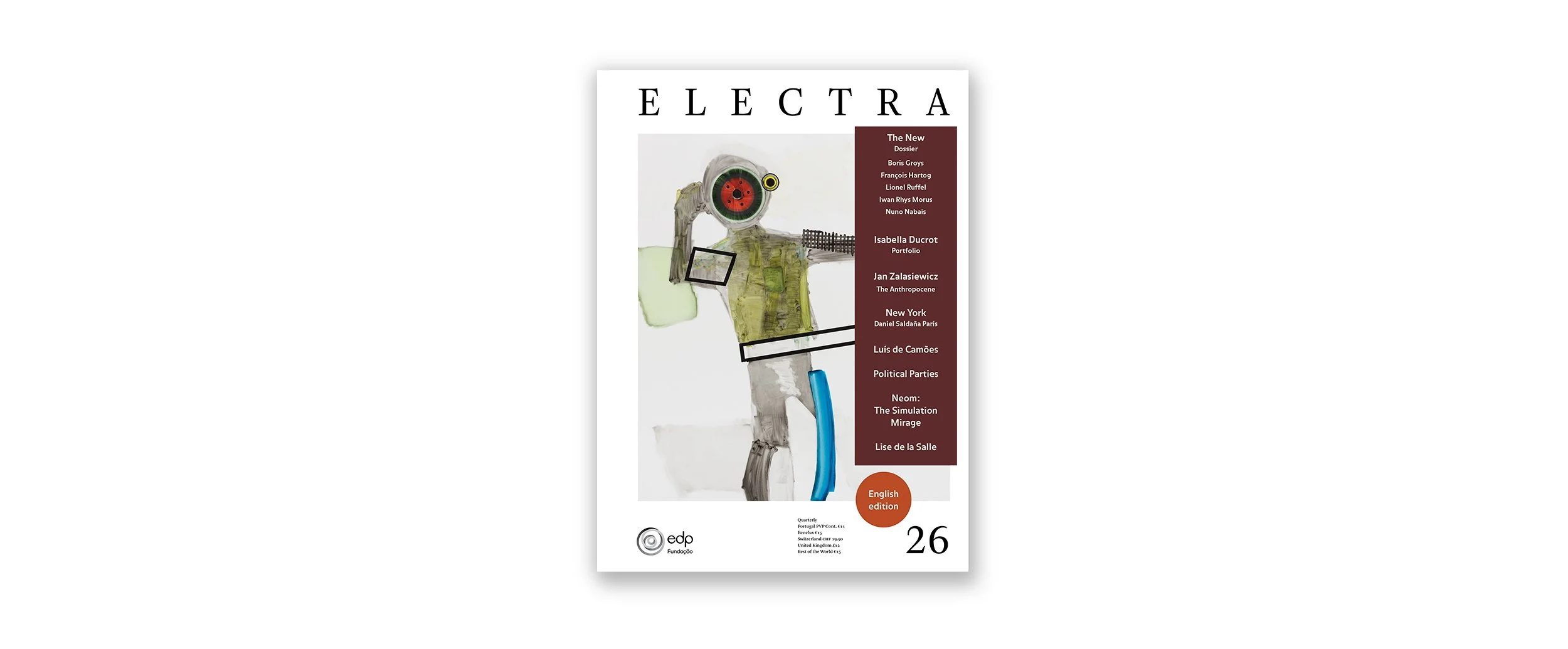....Electra 6 / Money..Electra 6 / Dinheiro....












....Electra 6 / Money..Electra 6 / Dinheiro....
....
This edition of Electra is one of the most diverse, in themes and authors of great international recognition.
A portfolio of artist and writer Edmund de Waal, also author of the cover of this issue, presents images and texts about his exhibition in Venice during the 2019 Biennial of Art. In addition, an unpublished sketchbook by Architect Siza Vieira, with a visual diary of your trip to Peru.
The magazine dossier is about Money. Because, as it is said in his presentation the power of money is everywhere, and everything determines, it is the last shaman we can invoke in this completely secularized world. Thus the philosopher Yves Citton speaks of the volatilization of money; Christophe Hanna links money to writing; Maurizio Lazzarato writes about money, debt and war; José Gabriel Pereira Bastos translates money by means of Anthropology and Psychoanalysis; António Vieira discusses the essay by Pierre Klossowki, A Moeda Viva; Margarida Abreu writes about the functioning of the monetary and financial system; the philosopher Anselm Jappe asks if the money can lead to madness and Nathalie Quintane travels the territory of contemporary art, its market and institutions.
.
Softcover, 27 x 20 cm, 271 pages
—
..
Esta edição da Electra é uma das mais diversas, em temas e autores de grande reconhecimento internacional.
É apresentado um portfólio do artista e escritor Edmund de Waal, também autor da capa deste número, com imagens e texto sobre a sua exposição patente em Veneza durante a Bienal de Arte 2019, e um caderno inédito de desenhos do Arquitecto Siza Vieira, com um diário visual da sua viagem ao Perú.
O dossier da revista é sobre “Dinheiro”. Porque, como se diz na sua apresentação o poder do dinheiro está em todo o lado, e tudo determina, é o último xamã que podemos invocar neste mundo completamente secularizado. Assim, o filósofo Yves Citton fala-nos da volatilização do dinheiro; Christophe Hanna liga o dinheiro à escrita; Maurizio Lazzarato escreve sobre a moeda, a dívida e a guerra; José Gabriel Pereira Bastos decifra o dinheiro recorrendo à Antropologia e à Psicanálise; António Vieira aborda o ensaio de Pierre Klossowki, A Moeda Viva; Margarida Abreu escreve sobre o funcionamento do sistema monetário e financeiro; o filósofo Anselm Jappe pergunta se pode o dinheiro levar à loucura e Nathalie Quintane percorre o território da arte contemporânea, do seu mercado e instituições.
.
Capa mole, 27 x 20 cm, 271 páginas
—
....
“....Everything is contentious in the Ghetto. The arguments start with the name, as all good long-running arguments should. My favourite derivation is that it is taken from getto, a place where the slag from the neighbouring copper foundry was thrown – a place for smelting work. And, thus by extension, a place of exchange and transformation. This place is embedded in metaphor. ..Tudo é controverso no gueto. A discussão começa pelo nome, como é de tom num debate que se presa – e se eterniza. A hipótese que mais me agrada é a da derivação de getto, o lugar para onde se atirava a escória de uma vizinha fundição de cobre: o lugar para um trabalho de fusão. E assim, por extensão, um lugar de permutas e transformações. Este é um lugar cravejado de metáforas. .... ”
“....Challenge, then, can be defined as that which puts individual courage on the right track. Find the true north of your personal courage by locating the almost insurmountable obstacle that suddenly materializes ahead, in the distance. Yes, the almost impossible is always a crucial category. ..O desafio poderia ser, então, aquilo que coloca a coragem individual na direcção certa. Saber o norte da coragem privada pela localização do obstáculo quase intransponível que subitamente surge lá à frente, ao fundo. E sim, sempre, o quase impossível como categoria central. ....”
“....People have a clear picture in mind when they hear the term ‘Bauhaus’: buildings with white-plastered, cubic facades, large black window frames made of steel, clear geometric shapes, a free floor plan, the use of steel and glass, and flat roofs. This architectural cliché has become synonymous with classic modernism. But the Bauhaus has achieved a lot more than just shaping a style. The famous German architecture and design school sprang from a unique zeitgeist and attitude that is more important than the stylistic heritage. ..Quando se ouve o termo «Bauhaus», de imediato se tem uma nítida imagem: edifícios de estuque branco, fachadas cúbicas, grandes armações de janelas em aço, formas claras e geométricas, definição espacial livre nas plantas dos edifícios, utilização de aço, vidro e telhados planos. Este cliché arquitectónico tornou-se sinónimo do modernismo clássico. Mas a Bauhaus conquistou muito mais do que a simples criação de um estilo. A famosa escola alemã de arquitectura e design emergiu de um Zeitgeist específico e a sua postura é mais importante do que a sua herança estética. ....”
-
....
Director / José Manuel dos Santos
Editor / António Guerreiro
Portfolio / Edmund de Waal
Published by Fundação EDP
Summer 2019Softcover, 27 x 20 cm, 271 pages
ISBN 978 972 8909 840.. Director / José Manuel dos Santos
Editor / António Guerreiro
Portfólio / Edmund de Waal
Publicado por Fundação EDP
Verão 2019Capa mole, 27 x 20 cm, 271 páginas
ISBN 978 972 8909 840....












XIII Ibero-American Biennial of Architecture and Urbanism Award!